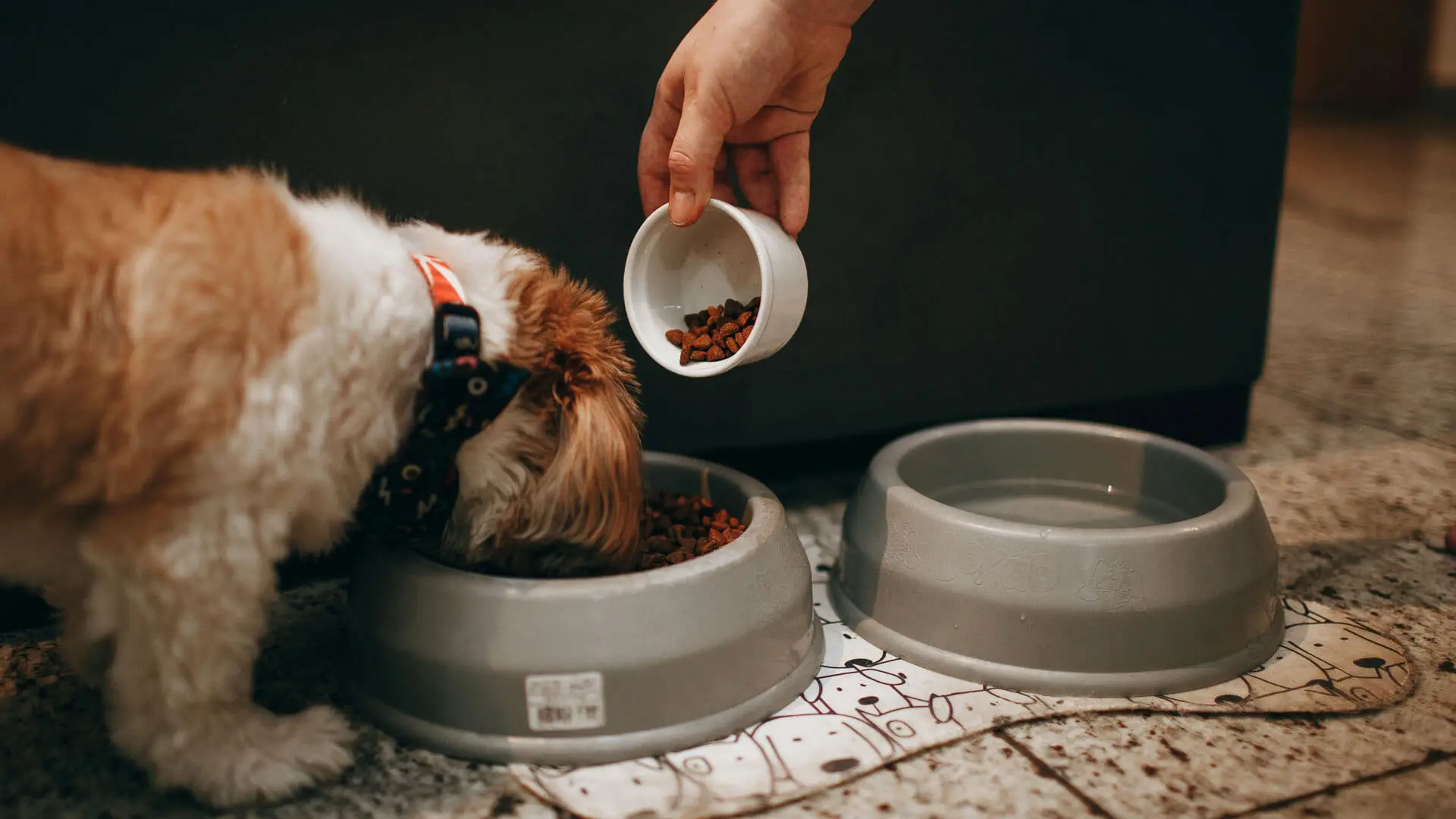Your fluffy puppy and your neighbor’s calm adult dog may both bark for treats, but their needs are worlds apart. Many pet owners don’t realize puppies and adults require different care. It’s like feeding a toddler steak vs baby formula.
Remember, puppy food packs nutrients for growing bones while adult food focuses on maintenance. One wrong swap could harm their health.
That’s why when you spend your life with your tail-wagging friend, you must stick with this question “When should I switch my puppy to dog food?”
And exactly that’s what this article is for.
Puppy food vs adult dog food – Major difference
According to AAFCO, puppy food must have extra protein, fat, calcium, and phosphorus. They help their muscles, bones, and energy levels. In simpler terms, puppy food is like a supercharged meal. The more calories keep up with their nonstop running around, and nutrients like omega-3s boost their brain and eye health.
On the flip side, for big puppies, like Labs or German Shepherds, too much calcium or fat can make their bones grow too quickly. This can lead to joint problems later. So, their food has less of those.
That’s why, once dogs hit adulthood, they don’t need all that extra fuel. At this age, their food should focus on keeping them healthy, not growing.
When to change from puppy food to dog food?
Generally, your puppies need adult dog food once they reach approximately 80% of their adult size. But that’s not the only thing to consider. Here are 4 important points to consider, too:
- Breed size
When making this food-witching decision, size matters a lot.For example, smaller pups (under 25 lbs) grow fast. They are usually ready by 9-10 months. Samelike, medium-sized dogs are of 25-50 lbs. They need more time and for them, you should aim for 12-14 months. Lastly, large breeds mean over 50 lbs like Great Danes, grow slower. You shouldn’t switch them until 14-24 months to avoid joint problems.
As per their size, it will be easier to make the right informed decision.
- Activity level
If your dog is always running, hiking, or training, they might need puppy food longer than others. As we mentioned above, puppy food has extra protein to build muscle, more fat for fuel, and calories to match their nonstop lifestyle. So, this keeps them strong and energized, especially for working dogs or agility champs. - Spaying or Neutering
Spaying or neutering changes your puppy’s needs. Their metabolism slows, so sticking with high-calorie puppy food can lead to weight gain.Also, you can switch from puppy to adult food sooner to avoid obesity, especially for couch-potato pups. And for large breeds, timing is extra important: switching too early might disrupt bone growth.
Unspayed females kept for breeding need puppy food longer to support healthy pregnancies. Tip? If your dog’s spayed but still hyperactive, mix adult food with puppy kibble temporarily. It balances calories without cutting energy.
- Health Checkups & Vet Guidance
Your puppies need vet-visits just like you go to your Doc to ensure your better health. Vet checkups will spot hidden factors, like slow-growing joints or food allergies, that affect when to switch.For example, a Chihuahua with a sensitive stomach might need adult food sooner, while a lean, active Boxer could stay on puppy kibble longer. Your vet’s guidance is more reliable than general charts!

How can I select the right adult dog food?
The young adult age in dogs starts usually when they’re around 1-4 years old. Starting proper feeding at this stage maintains muscle tone, keeps joints strong, supports a glossy coat, and prevents obesity.
- Wet food or dry food
Adult food also comes in two categories: wet and dry food. But what to select?
Wet food is great for hydration means perfect for picky drinkers. It has fewer calories per bite and is easier to chew. Seniors or tiny breeds can benefit from this category.Contrary, dry food costs less and helps control portions, keeps teeth cleaner, and can be used in puzzle toys to slow down speedy eaters.
Mixing both categories gives variety and balances perks. If your dog’s a messy eater, try a kibble-topper with wet food for excitement without the mess.
- Nutritional Requirements
While picking the right adult dog food, check the Guaranteed Analysis on the label, first.
Here, you can look for around 18% protein (for muscle) and 5.5% fat (for energy). Moreover, ensure it includes vitamins (like A and E) and minerals (calcium, phosphorus). Along with that, ingredients like omega-3s for shiny coats, glucosamine for joints, and probiotics for digestion should also be on your check-list.
Stress-Free Pet Parenting at CutePetsTips
At CutePetsTips, we share pet care insights with clear, practical advice you can trust. Along with answering the question, ‘When should I switch my puppy to dog food?’ you’ll find much more here, including health basics, behavior tips, and guidance on choosing the right dog.
Furthermore, our tips are vet-backed, easy to follow, and tailored to real-life challenges. Our mission is to make pet parenting a joyful experience.
Subscribing to our blog means raising a happier and healthier pup.
FAQs
When should I change my puppy to adult dog food?
Switching from puppy to adult dog food depends on four key factors like breed size, activity level, spaying/neutering, and health checkups & vet guidance.
What happens if I switch my puppy to adult food too soon?
If you switch too early, your puppy might not get enough nutrients for proper growth. This could lead to weak bones, joint problems, or poor muscle development.
Can adult dogs eat puppy food?
Adult dogs can eat puppy food. But it’s not recommended for long-term feeding. Puppy food has extra calories, fat, and nutrients designed for growth. This can lead to weight gain and health issues in adult dogs. However, in some cases like pregnant or highly active dogs, puppy food may be beneficial for extra energy.







